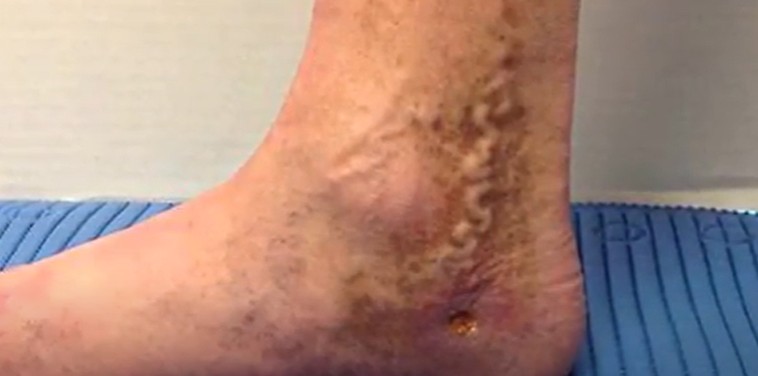Chronic Venous Insufficiency (CVI) is a widespread but frequently misunderstood vascular condition affecting millions globally. It develops when the leg veins struggle to return blood to the heart effectively, leading to blood pooling in the lower limbs.
This condition can lead to swelling, pain, skin changes, and even ulcers if left untreated. Understanding what causes CVI, how it progresses, and how it can be managed or cured is essential for maintaining vascular health and improving quality of life.
What is Chronic Venous Insufficiency?
Chronic Venous Insufficiency is a long-term condition in which the venous valves in the legs fail to function properly. In healthy veins, one-way valves assist in pushing blood upward toward the heart, preventing backflow. In CVI, these valves become damaged or weakened, allowing blood to flow backward (reflux) and pool in the legs. This results in increased venous pressure, which can cause visible vein enlargement (varicose veins), skin discoloration, and other symptoms.
Causes of Chronic Venous Insufficiency
CVI is usually the result of one or more underlying issues that interfere with normal venous return. The most common causes include:
- Valve Dysfunction: Damage to vein valves due to aging, prolonged standing, or injury can impair their ability to keep blood flowing in one direction.
- Deep Vein Thrombosis (DVT): A history of blood clots in the deep veins can damage these valves, reducing blood flow and leading to post-thrombotic syndrome—a type of CVI.
- Varicose Veins: These swollen, twisted veins are both a symptom and a contributing factor to CVI, often indicating valve failure.
- Genetics: A family history of venous disease increases the risk of developing CVI.
- Obesity: Excess body weight puts additional pressure on leg veins.
- Sedentary Lifestyle: Lack of movement weakens the calf muscles, which play a key role in helping blood move upward.
- Pregnancy: Hormonal changes and increased blood volume during pregnancy can stretch veins and weaken valves, increasing the risk of CVI.

Symptoms of Chronic Venous Insufficiency
Symptoms of CVI range from mild to severe and typically worsen over time if left untreated.
- Swelling in the lower legs and ankles
- Heaviness or aching in the legs
- Varicose veins
- Itchy or flaky skin on the legs
- Skin discoloration, especially around the ankles
- Leg cramps or throbbing pain
- Venous ulcers (open sores) near the ankles
Symptoms often worsen with prolonged standing or sitting and may improve with leg elevation or walking.
How is Chronic Venous Insufficiency Diagnosed?
Diagnosis usually begins with a physical exam and review of the patient’s symptoms and medical history. To confirm CVI and assess its severity, doctors may use:
- Duplex Ultrasound: This non-invasive imaging test uses sound waves to visualize blood flow and detect valve malfunction or clots.
- Venography: An X-ray of the veins using a contrast dye, less commonly used due to ultrasound’s effectiveness.
Treatment and Management Options
Although CVI is a chronic condition, it can be effectively managed. With timely treatment, symptoms often improve and, in some cases, can even be reversed.
1. Lifestyle Changes
- Exercise regularly: Activities like walking or cycling improve circulation.
- Weight management: Reduces pressure on leg veins.
- Elevate legs: Helps blood flow back to the heart.
- Avoid prolonged standing or sitting.
2. Compression Therapy
- Wearing compression stockings is the cornerstone of CVI management. Compression garments apply graduated pressure to the legs, enhancing circulation and reducing swelling.
3. Medications
- Venoactive drugs (such as flavonoids or horse chestnut extract) may reduce inflammation and improve vein tone.
- Diuretics may be used short-term for fluid retention but are not a long-term solution.
4. Minimally Invasive Procedures
- Endovenous Laser Ablation (EVLA) and Radiofrequency Ablation (RFA) are minimally invasive treatments that use heat to seal off damaged veins.
- Sclerotherapy: Involves injecting a solution into veins to collapse and seal them.
- Microphlebectomy: Small incisions are made to remove varicose veins.
5. Surgery
In severe cases, surgical intervention like vein stripping or bypass may be considered, although this is less common due to the effectiveness of minimally invasive options.
Can Chronic Venous Insufficiency Be Cured?
While CVI cannot always be completely cured—especially if it is caused by irreversible valve damage—it can be effectively managed. With proper treatment, most patients experience significant relief of symptoms and improved quality of life. Early intervention is essential to prevent serious complications such as skin ulcers or significant leg swelling.
Conclusion
Chronic Venous Insufficiency is a progressive vascular disorder that requires proper medical care and lifestyle modifications to manage effectively. Though it can cause significant discomfort and complications, modern medicine offers a range of effective treatments. If you experience symptoms like leg swelling, varicose veins, or persistent leg pain, consult a healthcare professional for proper diagnosis and a tailored treatment plan. Early detection and management are essential to maintaining healthy veins and an active life.
Read UState pulse and stay informed and Healthy.